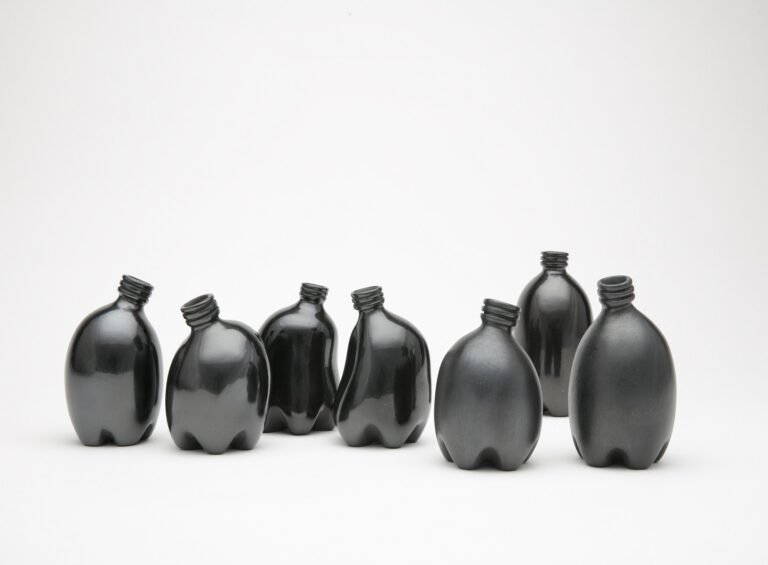Conceptual artist Jami Porter Lara (b. 1969; Spokane, Washington) explores connections between ideas that are typically set at odds: nature and artifice, art and trash, and past and present. Her work urges viewers to rethink these divisions by combining processes of the past with iconography of the present day. Her clay vessels, coil-built by hand, resemble the plastic bottle, an object that signifies recent human activity and material culture.
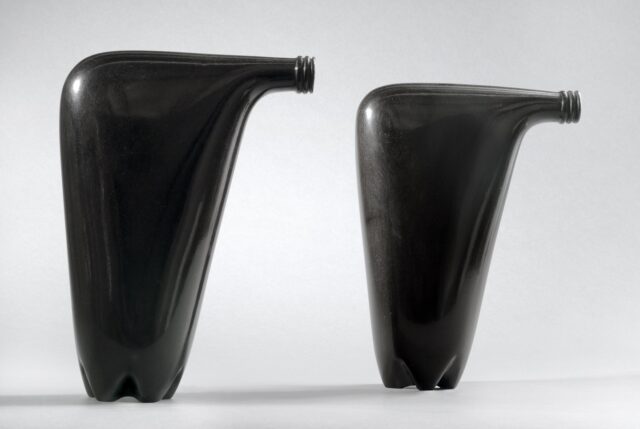
Jami Porter Lara, LDS-MHB-SNBR-0416CE-06 and LDS-MHB-SNBR-0416CE-07, 2016; Pit-fired clay, 10 x 7 1/2 x 3 in.; On loan from Evie and Ryan Simon; Photo by Geistlight Photography
This online exhibition includes text from the physical exhibition as well as quotations by Jami Porter Lara taken from an interview conducted by NMWA associate curator Ginny Treanor in the fall of 2016.
Additional quotations are from Porter Lara’s 2013 graduate thesis, interMIDDEN and are indicated as such.
We are grateful to Porter Lara for sharing her time with us and providing images for this online exhibition.
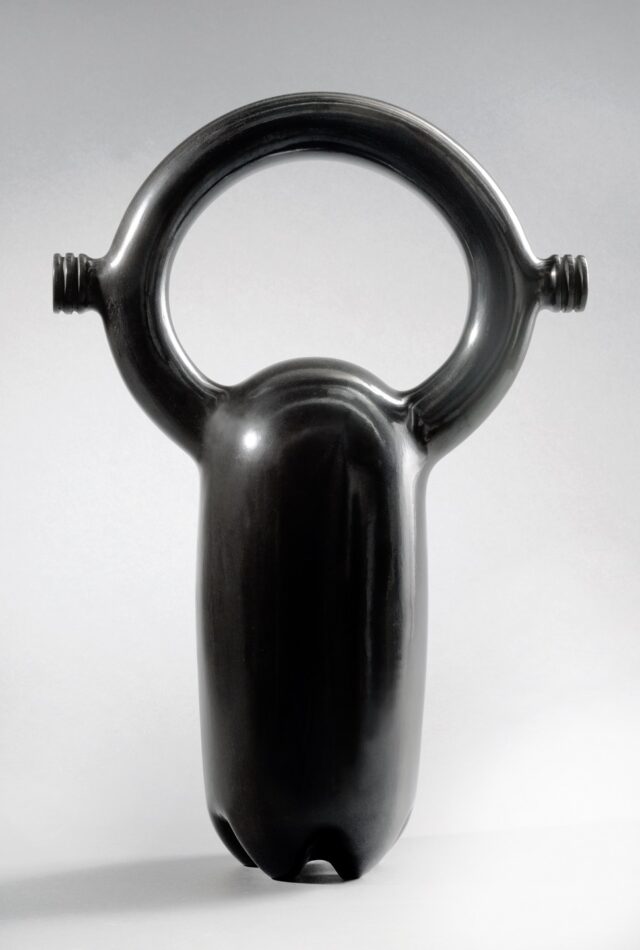
Jami Porter Lara, LDS-MHB-KABR-0316CE-01, 2016; Pit-fired clay, 14 x 9 1/2 x 4 in.; On loan from the collection of Scott Allocco and Douglas Clark; Photo by Geistlight Photography
“Mine is not a usual story. I wasn’t an artistic kid and I didn’t come from a family of artists. I decided to go to art school when I was 40….At the University of New Mexico, there’s a concentration you can do called Art and Ecology. It’s about the intersection of art and technology and nature. It’s a program that has a conceptual approach and, I would say, is very social practice-oriented…
But I got partway through it and I realized I was going to finish school and I wasn’t going to know how to make anything. I would know how to make ideas, I might know how to make experiences but I wanted to learn to make things.”
-Jami Porter Lara, in conversation with NMWA associate curator Ginny Treanor, 2016
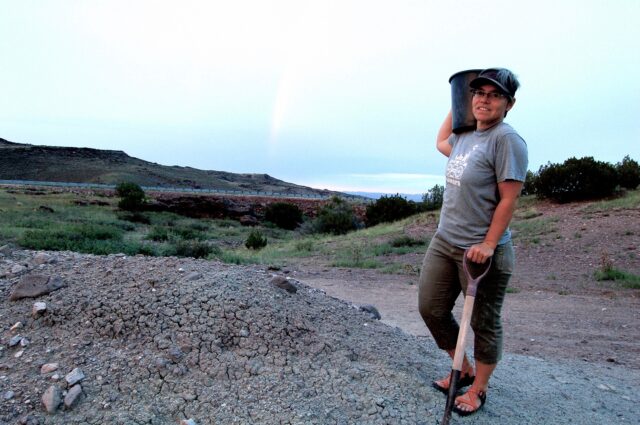
Jami Porter Lara harvesting clay by Jami Porter Lara
Porter Lara refers to her works as “contemporary artifacts,” in which she combines the contemporary shape of the plastic bottle with ancient ceramic techniques. She says, “The fact that the plastic bottle is one of the most common things that we make and use is not insignificant. Not only is it ubiquitous, it is an icon. By making plastic bottle forms out of clay, making them appear more like what we perceive as artifacts, my purpose is to hasten our awareness of the inevitability that these, too, will belong to the past.”
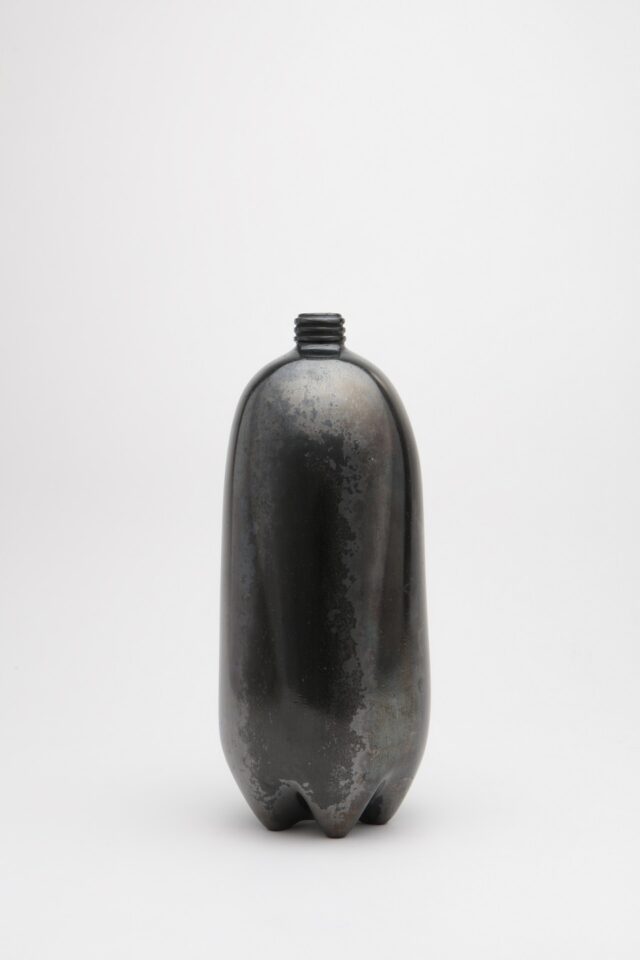
Jami Porter Lara, LDS-MHB-2LBR-0515CE-05, 2015; Pit-fired clay, 12 x 4 1/4 in. diameter; On loan from Christian Waguespack; Photo by Addison Doty
Embedded in Porter Lara’s titles are initials of the nicknames she gives each piece. Here, “GG” in the third section stands for “goose and gander,” which reinforces the zoomorphic quality of the forms.
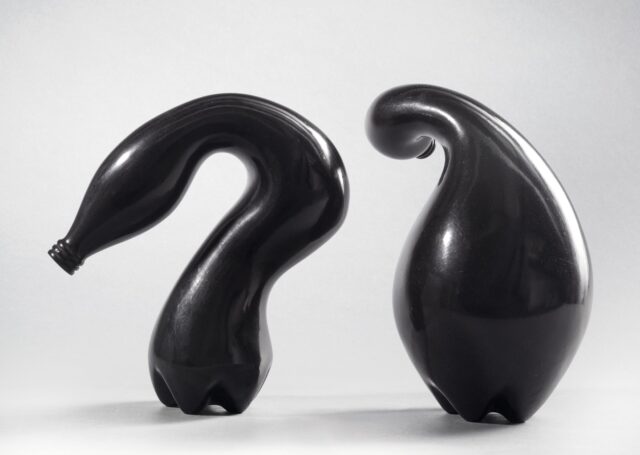
Jami Porter Lara, LDS-MHB-GGBR-0416CE-02, 2016; Pit-fired clay, 9 x 15 x 9 in. overall; Private Collection of Drs. Susanna McColley and Russell Brown; Photo by Geistlight Photography
The five-lobed shape found on the base of plastic bottles becomes the top of this vessel. Its rounded shape resembles a gourd, among the earliest vessels used by humans to carry and contain water.
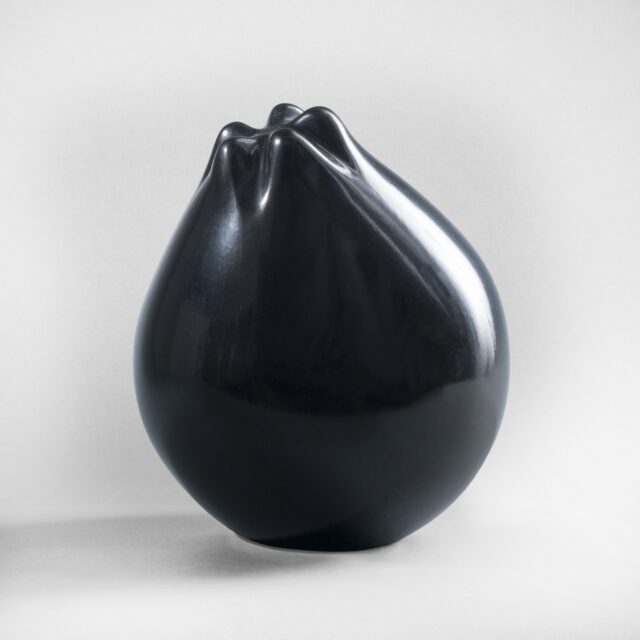
Jami Porter Lara, LDS-MHB-LPBR-0416CE-01, 2016; Pit-fired clay, 9 x 7 in. diameter; On loan from Emilie Porter-Rand and Marc Basiliere; Photo by Geistlight Photography
This work is reminiscent of a double-spouted vase, or “wedding vase,” a ritual object used by cultures stretching from the American Southwest to the Moche and Nasca cultures of ancient Peru.
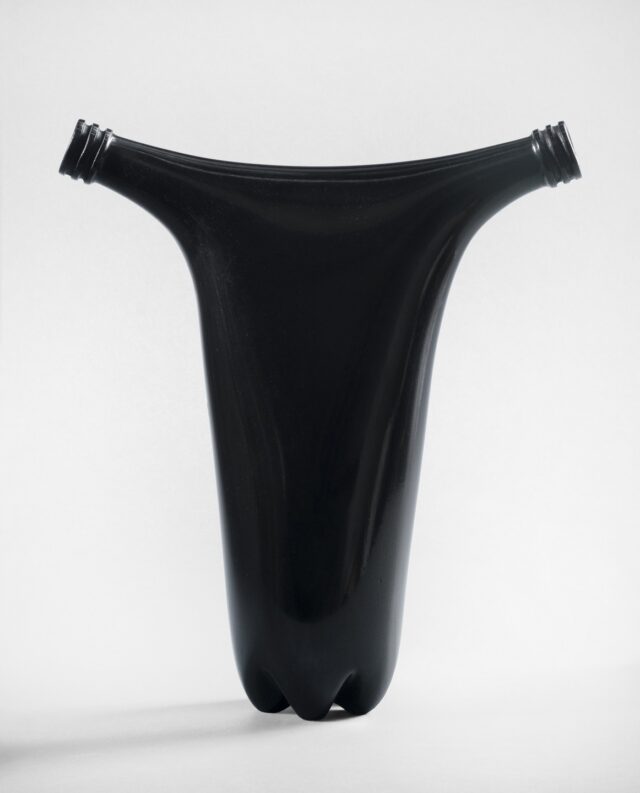
Jami Porter Lara, LDS-MHB-WVBR-0416CE-08, 2016; Pit-fired clay, 9 x 7 in. diameter; On loan from Emilie Porter-Rand and Marc Basiliere; Photo by Geistlight Photography
These vessels, part of a display of 108 small works, are functional rattles that Porter Lara made by inserting a small clay ball into each piece before the firing process. Rattles are often used during ceremonial or ritual events within many cultures for a variety of purposes. The number 108 carries spiritual meaning in several faiths, including Hinduism and Buddhism. It is also the average number of plastic bottles used annually by each U.S. resident that are not recycled.
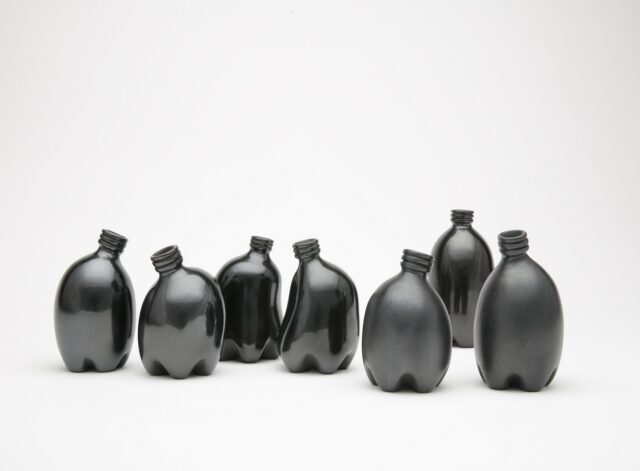
Jami Porter Lara, selected works from Go On Now, 2016; Pit-fired clay, 108 sculptures, 3–6 x 2 ½–3 ½ in. diameter each; Courtesy Central Features Contemporary Art; Photo by Addison Doty
“I was doing a semester-long program where I was traveling with 16 other artists around the Southwest. On one of our journeys we spent eight days right in the vicinity of the border in a fairly rural part of southern Arizona. We were right in the area where the border patrol was very active but people were also regularly crossing through. They’d been pushed into crossing through that area because of the heavy militarization of the border in the more urban areas and this was an ‘easier’ place to cross: in the desert through the mountains. And that was where I found two-liter bottles that people had been using to carry water and had left behind as they had used up the water.”

U.S.-Mexico Borderlands (2011) by Jami Porter Lara
“We crossed the border and drove to a town in northern Mexico called Mata Ortiz. Mata Ortiz is very close to a huge, well-preserved ruin called Paquimé built by the pre-Columbian Mogollon culture, which inhabited that region and all the way up into New Mexico to Chaco Canyon. [In the 1970s] there was basically Pueblo pottery revival in response to, I think, economic need. The people there started making ceramic pots that bore a lot of stylistic relation to the pot sherds and the artifacts that could be found in that vicinity.”
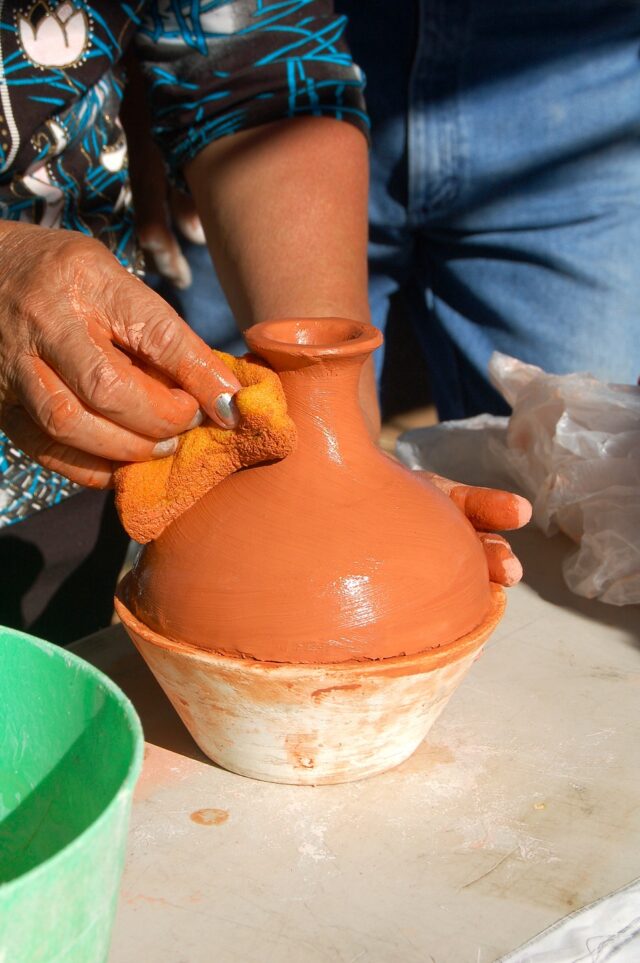
Learning to build pottery with coils (2011) by Jami Porter Lara
“A group of us went to stay with this family of accomplished potters, Graciela and Hector Gallegos, on their little ranch. We camped out in their horse pasture and during the day they taught us their technique for hand-building ceramics. That included them taking us into the mountains where they found their clay, with a pickax and a shovel and these big burlap bags. They showed us how to soak it [clay] and filter it, and then let it dry. They also taught us how to build out of coils and how to burnish with a stone.”
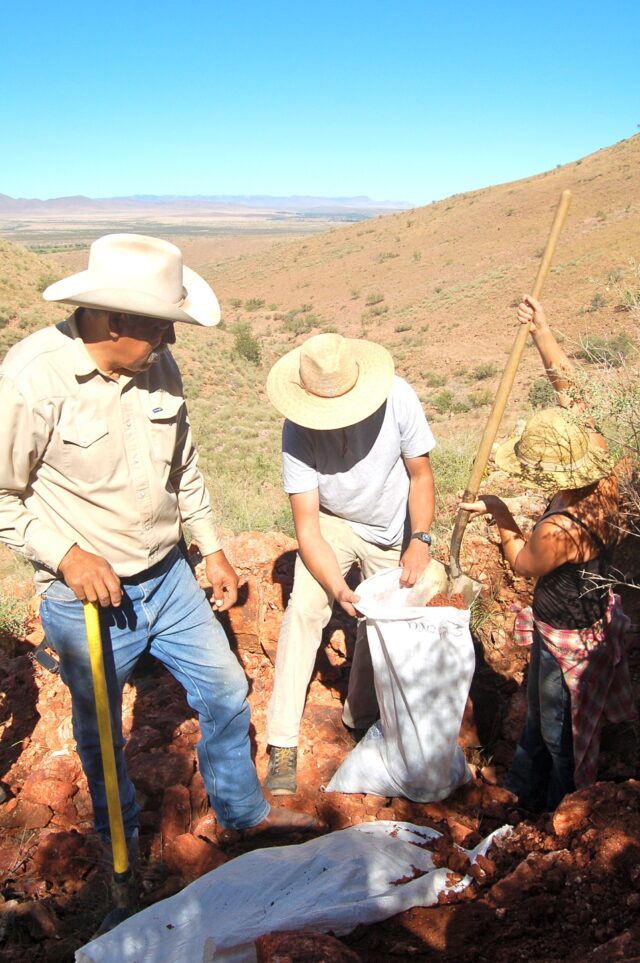
Harvesting clay in Mata Ortiz (2011) by Jami Porter Lara
“I hand-built my first ceramic vessel in the form of a two liter bottle. Using the method I learned in Mata Ortiz, I formed the bottom into the five pointed shape common to plastic bottles, and finished the top with a narrow, threaded mouth. The pot emerged from the firing with a crack…the result of my inexperience with the firing process, but the rift led me to think about the pot as an artifact.”
–interMIDDEN, 2013
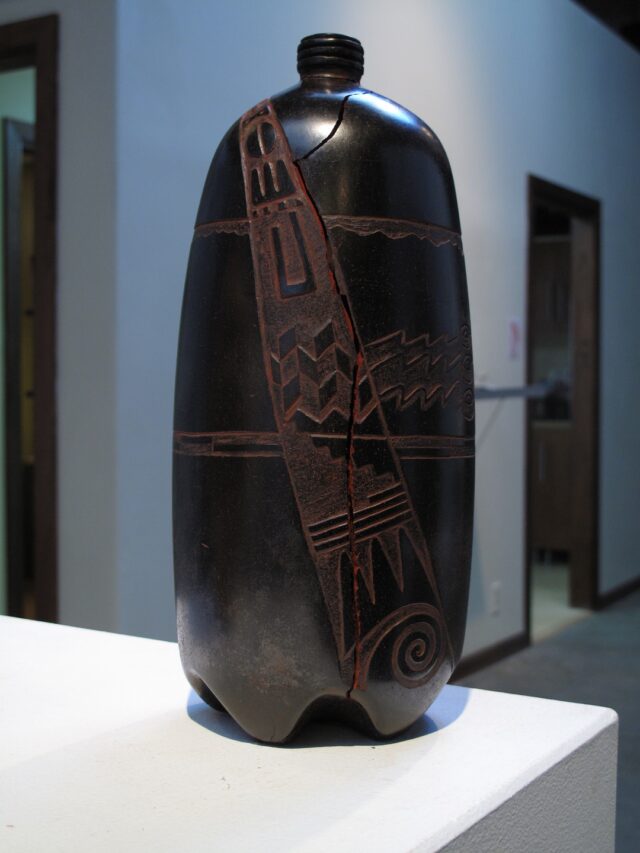
Jami Porter Lara’s first bottle-shaped work (2011) by Nina Dubois
“I dig clay from a place that’s about 60 miles south of my home in Albuquerque. It’s a place I learned about from other people who use clay from that place which is on public lands in an arroyo, which is a big gully. A couple times a year, maybe three times a year, I drive out to that place with a wheelbarrow and a pickax and a shovel and fill up five-gallon buckets with that clay which is just really dry and crumbly.”
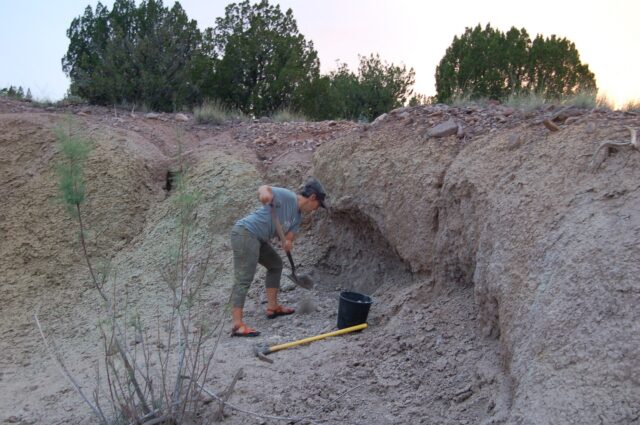
Jami Porter Lara harvesting clay
“I let it soak for a while and then I mix it with a paddle mixer and filter it through a fine mesh into other five-gallon buckets. I let it sit in the sun and settle for a while; it needs to dry out and reduce a bit. After that, I pour it onto stacks of towels to further wick away the moisture and dry it out. When that’s done, I wedge the clay, which is a way of kneading it to get out all of the air bubbles.”
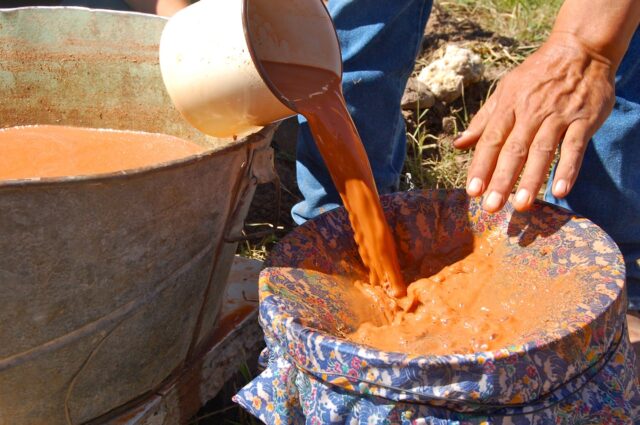
Preparing clay in Mata Ortiz (2011) by Jami Porter Lara
“The people who taught me [in Mata Ortiz] used what’s called a puki, which is like a shallow bowl, in which to mold the base of the vessel. In my case, I use plaster casts of the bottom of plastic bottles as a puki. I modify the mold, I’m using it more than anything for the symmetry, to get that pentagram, those five points on the bottom. But once I’ve made that I modify it quite a bit and open it up because the straight, vertical shape of an actual plastic bottle is too restrictive for the forms I want to make. I press the clay into that mold to the thickness of about half an inch. And then I make coils.”

Clay vessels before firing at Porter Lara’s studio (2011) by Jami Porter Lara
After the clay vessels dry, Porter Lara burnishes them with a flat stone to achieve a high sheen. Then she fires them in an outdoor pit. During this “reduction” process, flames and oxygen are kept away from the pottery, causing the clay bodies to turn black.
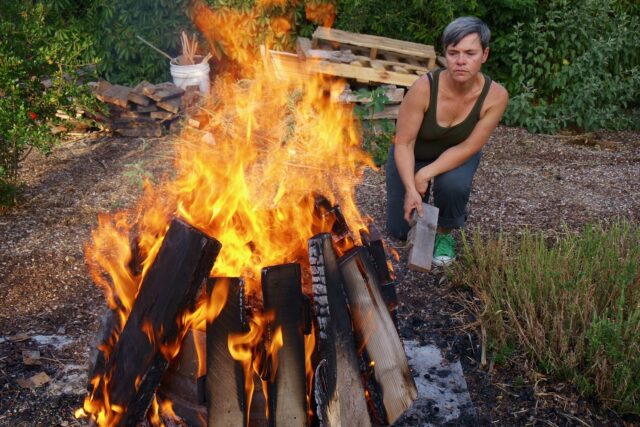
Jami Porter Lara firing clay at her home studio
This is a reproduction of a 2014 drawing that Porter Lara made to visualize her thought process as she was envisioning the concept behind the works on display in “Border Crossing.” Presented in it, among other things, are pictograph-like images that draw connections between vessels and people, trash and artifact, as well as what her work ultimately is, and isn’t, about. Explore Porter Lara’s Manifesto more deeply in the next few slides; all quotations taken from her text interMIDDEN.
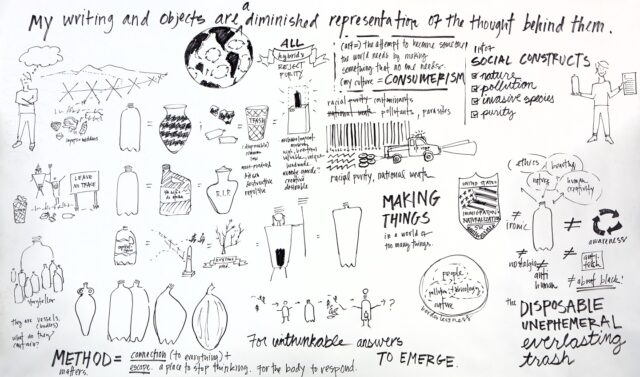
Jami Porter Lara, Making it Manifest, 2014; Marker on paper, 48 x 60 in.; Courtesy of the artist; Photo by Addison Doty
“One thing that really interested me was walking along the border fence, which in that area is just a vehicle barrier, ironically constructed out of the rails from the railroad that used to connect Mexico with parts of what we now know as New Mexico, Arizona, and California.”

Jami Porter Lara, Making it Manifest, 2014; Marker on paper, 48 x 60 in.; Courtesy of the artist; Photo by Addison Doty
Porter Lara explores connections between ideas that are typically set at odds: nature and artifice, art and trash, and past and present. She recognizes that the plastic bottle belongs to the long human history of making functional vessels that contain and transport water, while it also expresses human creativity and ingenuity. Porter Lara views her vessels as stand-ins for the human body. Like human figures, each vessel is unique, and some, like this work, appear to have a distinct “head,” “shoulders,” and “feet.”

Jami Porter Lara, Making it Manifest, 2014; Marker on paper, 48 x 60 in.; Courtesy of the artist; Photo by Addison Doty
“As a culture, we are beginning to recognize that disposable plastic is a problem. Soon, either because we legislate it out of existence or because we run out of the oil to make it, plastic will be an artifact of the past. Leave No Trace is a set of guidelines for limiting certain types of impacts by recreational tourists to parks and wilderness areas. Literally, it is an impossibility…symbolically, it is the paradox at the heart of environmentalism: the construction of nature as entirely separate from humans. To the extent that we see nature as something ‘out there’ and apart from us, we will not see it as ‘in here,’ the place we call home.”

Jami Porter Lara, Making it Manifest, 2014; Marker on paper, 48 x 60 in.; Courtesy of the artist; Photo by Addison Doty
“The construction of wilderness as pristine nature has denied me a place in nature….Realizing that consumer culture is my culture, I choose it as my starting point. interMidden makes things in a world of too many things. It makes things that imitate the things that we have too many of. It wants to be earnest. It does not want to be ironic. It is the search for the ethical, open-eyed, and un-nostalgic.”

Jami Porter Lara, Making it Manifest, 2014; Marker on paper, 48 x 60 in.; Courtesy of the artist; Photo by Addison Doty
Text adapted from the Border Crossing exhibition script. Quotations by Jami Porter Lara come from an interview conducted by NMWA associate curator Ginny Treanor in November 2016, and from Porter Lara’s graduate thesis, interMIDDEN, 2013.
Images courtesy of Jami Porter Lara, Nina Dubois, Addison Doty, Geistlight Photography, and Emily Haight for NMWA.
Go back to the Border Crossing exhibition page.

Jami Porter Lara, selected works from Go On Now, 2016; Pit-fired clay, 108 sculptures, 3–6 x 2 ½–3 ½ in. diameter each; Courtesy Central Features Contemporary Art; Photo by Addison Doty

